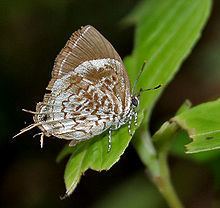Order Butterflies and moths | Species R. amor Rank Genus | |
 | ||
Similar Surendra, Charana, Iraota, Butterflies and moths, Loxura | ||
Rathinda is a monotypic butterfly genus in the family Lycaenidae. Its one species, Rathinda amor, the monkey puzzle, is found in southern Asia.
Contents
- Butterflies life cycle munkey puzzel rathinda amor srilanka
- Distribution
- Status
- Description
- Habits
- Larva
- Pupa
- Food plants
- References
Butterflies life cycle munkey puzzel rathinda amor srilanka
Distribution
The species resides in India's Western Ghats, the southern Indian plains (as far north as Bangalore), Odisha and Ganjam district and to Kolkata, Assam, Bangladesh and Sri Lanka.
Status
The species is not rare in India. It is common and present in all the Western Ghats districts of Kerala, Karnataka, Tamil Nadu and Goa. It is common but not found in all the Ghat districts of Maharashtra and does not occur in Gujarat at all (Gaonkar). However, there are recent records confirmed from Gujarat as far as up to Surat.
Description
Habits
This butterfly is found in jungle areas of moderate to heavy rainfall, in heavy forest and scrub. The butterfly occurs below 900 meters or so. It keeps to undergrowth and can be seen along forest paths and in clearings.
The butterfly has a weak flight, it stays low and does not fly for long without alighting. Its method of alighting is interesting - as soon as it lands, it turns around and waggles its tail filaments, it also sidesteps for a while - all this is apparently to confuse a predator as to which side is the head. This is a likely reason that the first naturalists may have named the species the monkey puzzle.
Larva
The larva is unusual for a lycaenid. It is pale green and has a long line of fleshy protrusions along the back. The protuberances near the head are branched in two. On the fourth segment the protuberance is straight and has a sharp point. The last segments have two protuberances each curved outwards. The last protuberance is curved outwards and upwards. According to Evans, the larva supposedly resembles a monkey's head hence the name.
Pupa
The pupa is green and turns brown as it nears maturity. The back of the abdomen is pink and smooth. The pupa is attached by one point only - by a long stalk at the tail.
Food plants
The butterfly has a number of food plants from families Rubiaceae, Dipterocarpeae, Euphorbiaceae, Loranthaceae, Sapindaceae and Myrtaceae and the species Mangifera indica and Meiogyne pannosa.
